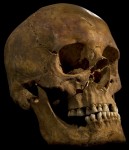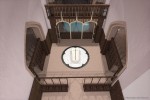 After more than a year of legal wrangling, a High Court has ruled that the remains of King Richard III will be reburied in Leicester Cathedral as originally planned. The claimant in this case is The Plantagenet Alliance, an organization created by Stephen Nicolay, 16th great-nephew of Richard III, specifically to contest the burial plans. He and 14 other people descended from Richard’s siblings (the king himself has no direct descendants) wanted Richard’s remains to be interred in York Minster because they believed that to have been wish in life, so they contested the exhumation license granted by the Ministry of Justice to the University of Leicester Archaeological Service (ULAS).
After more than a year of legal wrangling, a High Court has ruled that the remains of King Richard III will be reburied in Leicester Cathedral as originally planned. The claimant in this case is The Plantagenet Alliance, an organization created by Stephen Nicolay, 16th great-nephew of Richard III, specifically to contest the burial plans. He and 14 other people descended from Richard’s siblings (the king himself has no direct descendants) wanted Richard’s remains to be interred in York Minster because they believed that to have been wish in life, so they contested the exhumation license granted by the Ministry of Justice to the University of Leicester Archaeological Service (ULAS).
On August 24th, 2012, the first day of excavations under the Leicester Council parking lot that researchers believed was the site of the Greyfriars church, archaeologists uncovered human bone. They stopped digging immediately in accordance with the Burials Act of 1857 and on August 31st team leader Richard Buckley applied for an exhumation license. The application proposed to exhume “up to six sets of human remains for scientific examination” with any excavated remains to be kept in the Jewry Wall Museum with the exception that “in the unlikely event that the remains of Richard III are located the intention is for these to be reinterred at St Martin’s Cathedral, Leicester.”
 The license for “the removal of the remains of persons unknown” from the Greyfriars site was granted on September 3rd, 2012. Once they had the license, the ULAS team excavated the bones fully and found two skeletons, one of which had the tell-tale curved spine and sharp force injuries of Richard III. Then came the DNA analysis and other tests that confirmed they had indeed discovered the remains of the last Plantagenet king of England. The announcement of the discovery was made on February 4th, 2013, an unforgettable day here on the blog.
The license for “the removal of the remains of persons unknown” from the Greyfriars site was granted on September 3rd, 2012. Once they had the license, the ULAS team excavated the bones fully and found two skeletons, one of which had the tell-tale curved spine and sharp force injuries of Richard III. Then came the DNA analysis and other tests that confirmed they had indeed discovered the remains of the last Plantagenet king of England. The announcement of the discovery was made on February 4th, 2013, an unforgettable day here on the blog.
On May 3rd, 2013, The Plantagenet Alliance filed for a judicial review of the exhumation license. Their legal argument was that the Ministry of Justice should have consulted more widely with other interested parties (ie, the descendants) and the public once they realized that the “persons unknown” cited in the license included a king of England. The Secretary of State would seek the consent of relatives of an identified exhumed person in other circumstances, so they should have in this case as well.
The High Court ultimately disagreed. They ruled the MoJ had no duty to consult, that there is no established practice that would require the Justice Secretary to consult with collateral relatives of someone who died 500 years ago. The uniqueness of the circumstances — the excavation of a king of England — is no basis for expanding the law since there could be all kinds of exceptional circumstances that don’t involve kings. The people and institutions who needed to be considered were.
This case undoubtedly has unique and exceptional features which arguably call for special consideration. It is why the claim has reached this Court. The archaeological discovery of the mortal remains of a King of England after 500 years may fairly be described as “unprecedented”. The discovery touches on Sovereign, State and the Church. To the extent that these unique features call for special consideration, it may well be that the decision-maker is required by law to ascertain at least the views of Sovereign, State and the Church. In our view, however, at all material times in this case the Secretary of State was sufficiently aware of the views of Sovereign, State and the Church to be able to make an informed decision.
 You can read the entire decision here (pdf), and it’s very much worth it. The court lays out the whole history, from Richard’s life and death at the Battle of Bosworth to how the excavation came together to the discovery, the reburial politics from Council to Parliament and of course the legal challenge. Fun fact: Philippa Langley was talking to the Ministry of Justice about what to do in case Richard’s remains were found starting in January of 2011, believe it or not. She even touched base with the Private Secretary of Prince Richard, Duke of Gloucester, grandson of King George V, first cousin to Queen Elizabeth II and patron of the Richard III Society to see where the Royal Household stood on the question. They supported the excavation in a distant sort of way, with the only locus of concern being that the remains were handled with respect.
You can read the entire decision here (pdf), and it’s very much worth it. The court lays out the whole history, from Richard’s life and death at the Battle of Bosworth to how the excavation came together to the discovery, the reburial politics from Council to Parliament and of course the legal challenge. Fun fact: Philippa Langley was talking to the Ministry of Justice about what to do in case Richard’s remains were found starting in January of 2011, believe it or not. She even touched base with the Private Secretary of Prince Richard, Duke of Gloucester, grandson of King George V, first cousin to Queen Elizabeth II and patron of the Richard III Society to see where the Royal Household stood on the question. They supported the excavation in a distant sort of way, with the only locus of concern being that the remains were handled with respect.
The Plantagenet Alliance has not commented on the decision yet but they do have a three week window in which to lodge an appeal. Richard Buckley and the University of Leicester spokesperson are delighted, as is the Dean of Leicester who said at a press conference that they’re aiming for a burial ceremony in spring of 2015.